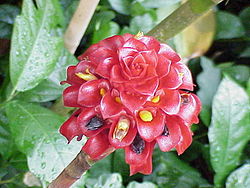| Tapeinochilos | |
|---|---|
 | |
| Tapeinochilos ananassae | |
| Scientific classification | |
| Kingdom: | Plantae |
| Clade: | Tracheophytes |
| Clade: | Angiosperms |
| Clade: | Monocots |
| Clade: | Commelinids |
| Order: | Zingiberales |
| Family: | Costaceae |
| Genus: | Tapeinochilos Miq. |
| Synonyms [1] [2] | |
| |
Tapeinochilos is a group of plants in the Costaceae described as a genus in 1869. [3] [2] [4] It is native to Queensland, Papuasia, and the Indonesian Province of Maluku. [1] Centered in Papua New Guinea, only three of the approximately 16 species occur outside of the country. [5]
